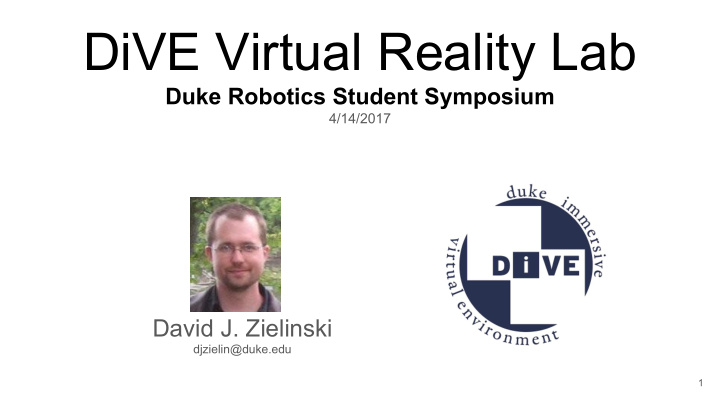



DiVE Virtual Reality Lab Duke Robotics Student Symposium 4/14/2017 David J. Zielinski djzielin@duke.edu 1
DiVE Lab Personel Dr. Regis Kopper Assistant Research Professor of Mechanical Engineering and Materials Science Director of the Duke immersive Virtual Environment (DiVE). David J. Zielinski Research and Development Engineer for the DiVE Joanne Grosshans Administrative assistant for the DiVE 2
DiVE Facilities Oculus CV-1 HTC VIVE Microsoft Hololens Zspace Duke immersive Virtual Environment Establish 2005, Upgraded 2015 3
History of VR 1968 - Ivan Sutherland 1929 - Edward Link 1956 - Morton Heilig mechanical flight simulator “Sensorama” tracked stereoscopic HMD 1989 - Jaron Lanier 1992 - Carolina Cruz-Neira “Virtual Reality” coined CAVE System 4 1992 1999 Commercial VR 4
Second Wave of VR 2014 - Mark Zuckerberg 2012- Palmer Luckey 2016 - Microsoft Oculus acquired by Facebook for $2B Oculus Rift Kickstarter Hololens Released 5
VR + Robotics? Simulating the sense of Explore human robot Telepresence / Remote Operator touch in VR (Haptics) collaboration/interaction from the safety of VR 6
Some Academic VR Research Questions What effect do system parameters (i.e. display fidelty) What causes / reduces simulator sickness? have on user experience / performance? How can users interact with virtual How well does training in a VR simulation, transfer to real world skills? worlds in novel ways? 7
Recent Research in the DiVE... 8
Marksmanship in Virtual Reality Hrishikesh Rao, Jillian Clements, Greg Appelbaum, Marc Sommer, Regis Kopper, David Zielinski, Nick Potter Olympic trap shooting Virtual simulation in the DiVE 9 Goal: study human motor learning
Markmanship Results 10
Marksmanship + EEG Preliminary results: eye movements 11 are larger, faster with training
Emotional Qualities of VR Spaces (IEEEVR 2017) Asma Naz, Regis Kopper, Ryan McMahan, Minhai Nadin Color (Blue, Orange) Brightness (Light, Dark) Texture (Rough, Smooth) 12
Emotional Quality Results Emotional responses were consistent in simulated spaces to those in the real world. Interesting interaction effects found. 13
DiVE Project: Specimen Box (3DUI 2017) David J. Zielinski, Derek Nankvil, Regis Kopper ● Clear acrylic box ● User can touch the box ● Can't reach contents Inspiration: Normally hard to do tangible interfaces in Historical “Specimen Jars” world-fixed systems, as they are visible to user. Late 1700s. 14
Specimen Box Faster, Less Rotation Specimen box: time significantly lower p<.05 ● Accuracy of user’s movements? ● Less overshoot? ● Proprioception? ● Need additional experiments! rotation significantly lower p<.0001 ● Avoid spending additional energy with weighted object? ● Good for training transfer? 15
Classes ISS 320S: Introduction to Programming and User Interface Design in Unity 3D (Fall) ME 555.05: Virtual Reality Systems Research and Design (Spring) David J. Zielinski ISS 320S Final Projects Fall 2016 djzielin@duke.edu https://youtu.be/S6MFgpLoT4Y Thank you for your Attention! DiVE Open Houses Thursday 5pm-6pm 16
Bonus Slides 17
Domain Specific Applications of VR Virtual Prototyping Visualization Entertainment Training Pre-vis architecture Molecules Horror Medical 18 Products testing Geology Sports Military 18
Specimen Box Limitations Box was too heavy (2.1kg) Could make walls thinner, make box smaller. Specimen Box Future Work Use technique for object translation and placement 19
Recommend
More recommend